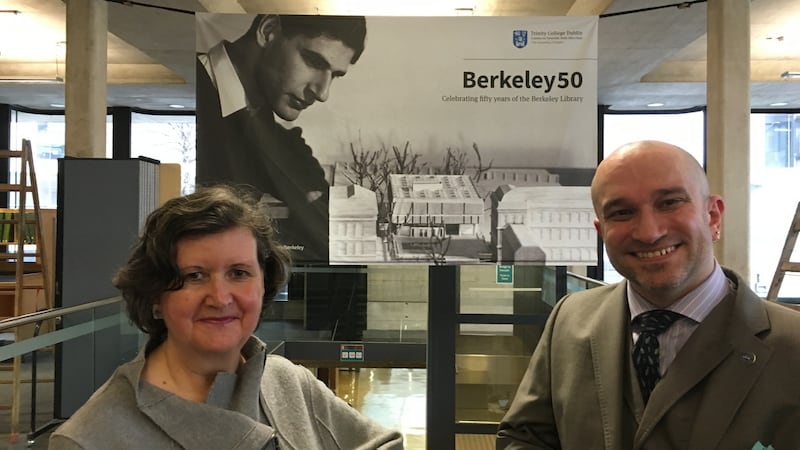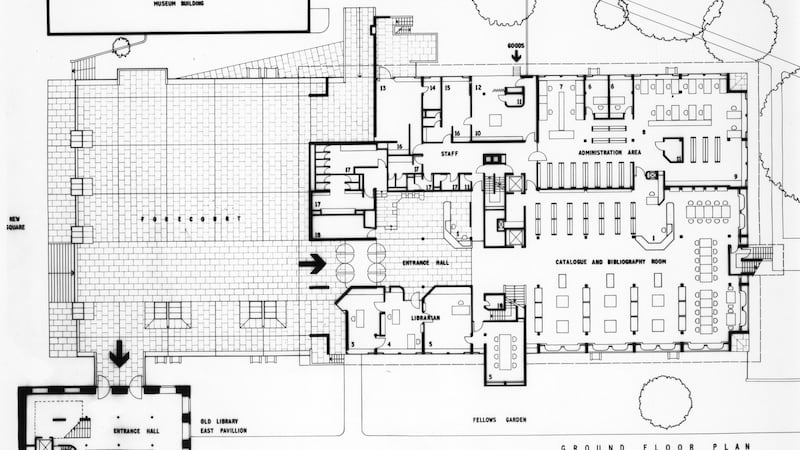The Berkeley Library in Trinity College Dublin is one of those rarities of modern architecture – a brutalist, concrete mass with an above ground bunker feel to it, but one that was hailed from the outset and which now, 50 years after it was built, is loved by many of those who work in it every day.
"It's a very high quality building," says college librarian and archivist Helen Shenton whose ground floor office looks out over College Park, perhaps one of the most pleasing views in central Dublin. "It's been described as 'hand-crafted'" – which is partly true.
It was designed by the Austrian-born British architect Paul Koralek, who won an international competition for the building, his first major commission, at the extraordinarily young age of 28. It was built by G+T Crampton, opening its doors to students in 1967.
This week saw the launch of Berkeley50, a year-long calendar of events celebrating the building and much else that is connected with it – from philosophy, law and science, to literature and innovation.
Apart from some Wicklow granite cladding on the exterior upper facade, the building is made entirely of concrete, mixed on site and poured into moulds of Douglas Fir wooden planks. The walls remain bare, displaying the grain and knots of the wood that formed them – timber fingerprints in effect; that hand crafted-appearance, despite the monumental scale of the building.
Tall, curved plate glass windows look west over what was Fellows Garden (now Fellows Square) and east across College Park. Deeper inside the building, which is full of concrete nooks, crannies and alcoves – including some solid desks and book encasements – there are large open space reading areas, atriums lit by skylights and glass-topped concrete light silos.
Almost all of the original desks (chrome and blue leather-covered metal) remain, as do individual chairs, window seating and free-standing, thick plywood bookshelves. It was designed to seat 470 students and if it has a structural flaw, it is its inflexibility – the interior cannot be rearranged with ease, if at all, and recabling to serve technical innovation is also very difficult.

Fifty years on, interior and exterior retain both a modern and futuristic appearance. It cost IR£800,000 to build – "probably about €25 million now," says Berkeley staff member Greg Sheaf.
On its debut, this newspaper’s architectural correspondent pronounced the building a “brilliant success” that was “immensely satisfying”.
“This large and complex building,” he enthused, “has the quality that one associates with all great architecture, as distinct from mere good buildings - a sense of mystery, a sculptural sense of having a far side, out of sight, which will be worth walking around to see.”
Digitalisation has made redundant the large ledger-style catalogues, card indexes and microfilms
This was, he wrote, despite the “screaming protests of functionalists”. Critics remain; some of today’s 13,000 undergraduate students feel it is a cold, soulless place, preferring the added-on Ussher Library to the rear.
Known initially as the New Library, but later named formally after Bishop Berkeley, the 18th century Trinity student and philosopher (he pioneered the notion that objects exist only through being perceived, suggesting, perhaps, that if one closes one’s eyes, the Berkeley isn’t there), the library differed from others in Trinity – the 18th century Long Room and the nearby 1937 Reading Room, now known as the Post-Graduate Reading Room.
"In some sense, they are designed around the books rather than the user,” says Ms Shenton. “[With the Berkeley] you start out with the services to readers and the spaces they use.”
Trinity is a copyright library book recipient along with Oxford, Cambridge, Edinburgh and the British Museum, which means that by law it must be given, free, a copy of all books published in Britain.
In 1967, the college was taking in 35,000 such books annually. Today, the figure is 70,000 copyright books, with another 70,000 being bought every year. The full college library collection amounts to some six million volumes, one million of which are held in the Berkeley, the remainder being warehoused in Santry.
Digitalisation has made redundant the large ledger-style catalogues, card indexes and microfilms, listing the Dewey Decimal identification and retrieval number of all books in the collection. This means, in turn, that the open plan ground floor Iveagh Hall that used to house them, and where library staff remain to assist students, can be re-imagined.

"We're moving away from storage to having more dynamic spaces," according to Peter Dudley, Berkeley50 co-ordinator. "Library spaces have to be more suitable now to all kinds of study. [The Iveagh Hall] may in future be a casual, informal study space for group learning. Libraries are no longer quiet monastic study spaces."
Part of this year's celebrations will include filming a performance of Krapp's Last Tape, whose author, Samuel Beckett, donated a year's royalties to construction costs. The performance will be watchable on smartphones.
“It will be filmed here and then you can watch it sitting here,” says Helen Shenton. “This will exemplify what Berkeley at 50 is about – cutting edge and tradition. We are Janus-faced and we have to steward that responsibility.”
A measure of its success as a piece of architecture is that fact that the Berkeley and nearby Hawkins House were built contemporaneously. One is about to be demolished; the other is a protected structure.
As Krapp himself pondered, somewhat obsessively, "perhaps my best days are gone. . ." Perhaps, but perhaps not for the Berkeley. Further information on Berkeley50 from tcd.ie/library/berkeley/ and also Twitter #berkeley50












